

Helium - Element information, properties and uses. Transcript : (Promo) You're listening to Chemistry in its element brought to you by Chemistry World, the magazine of the Royal Society of Chemistry.
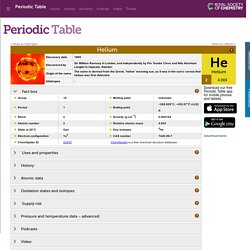
(End promo) Chris Smith. Helium - Element information, properties and uses. SolCalc - List of chemical compounds. The Top 10 Industrial Chemicals - dummies. By John T.
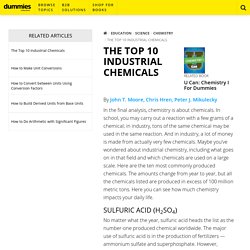
Moore, Chris Hren, Peter J. Mikulecky In the final analysis, chemistry is about chemicals. In school, you may carry out a reaction with a few grams of a chemical; in industry, tons of the same chemical may be used in the same reaction. Chemical industry. Oil refinery in Louisiana - an example of chemical industry The chemical industry comprises the companies that produce industrial chemicals.
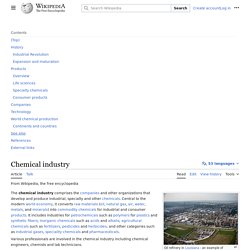
Central to the modern world economy, it converts raw materials (oil, natural gas, air, water, metals, and minerals) into more than 70,000 different products. The plastics industry contains some overlap, as most chemical companies produce plastic as well as other chemicals. The periodic table: from its classic design to use in popular culture. The periodic table is one of those classic images that you find in many science labs and classrooms.

It’s an image almost everyone has seen at some time in their life. You can also find the periodic table on t-shirts, mugs, beach towels, pillowcases and duvet covers, and plenty of other items. BBC Bitesize - KS3 Chemistry - Atoms, elements and compounds - Revision 1. Kech103. 20 Things You Didn't Know About... The Periodic Table. 1 You may remember the Periodic Table of the Elements as a dreary chart on your classroom wall.
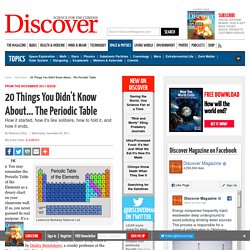
If so, you never guessed its real purpose: It’s a giant cheat sheet. 2 The table has served chemistry students since 1869, when it was created by Dmitry Mendeleyev, a cranky professor at the University of St. Petersburg. 3 With a publisher’s deadline looming, Mendeleyev didn’t have time to describe all 63 then-known elements. So he turned to a data set of atomic weights meticulously gathered by others. TeachText. Periodic primo. Periodic table. The organization of the periodic table can be used to derive relationships between the various element properties, but also the predicted chemical properties and behaviours of undiscovered or newly synthesized elements. Russian chemist Dmitri Mendeleev was the first to publish a recognizable periodic table in 1869, developed mainly to illustrate periodic trends of the then-known elements.
He also predicted some properties of unidentified elements that were expected to fill gaps within the table. Essential Science: What are the limits of the periodic table? This is a question posed by Michigan State University professor in a new opinion-based science paper.

The researcher in question is Witek Nazarewicz, who holds the distinction of being the Hannah Distinguished Professor of Physics. Nazarewicz reflects by considering the most recent additions to the table. List of manufacturing processes. Interactive Periodic Table of the Elements, in Pictures and Words. USES and APPLICATIONS of CHEMICALS elements compounds mixtures formulations. (i) Coal: Mainly carbon from plant remains but contains small amounts of minerals and organic compounds.

Coke is made by roasting coal at a high temperature which drives off organic tar, ammonia gas and water. (ii) Graphite: It has a porous structure so readily absorbs gases and certain dissolved compounds in solutions. Slippery black solid, high melting point, relatively good conductor of heat or electricity, doesn't dissolve in anything. Charcoal and coke have very porous graphitic structure. (iii) Diamond: A very hard and high melting colourless (usually) crystals. Elements Found in Household Products. Elements Found in Household Products. MATTER AND MATERIALS. PERIODIC TABLE. At first glance, the periodic table looks very complex.
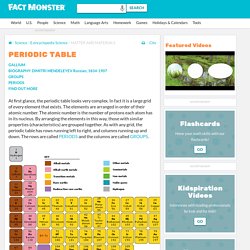
In fact it is a large grid of every element that exists. The elements are arranged in order of their atomic number. The atomic number is the number of protons each atom has in its nucleus. Periodic Table – Royal Society of Chemistry.